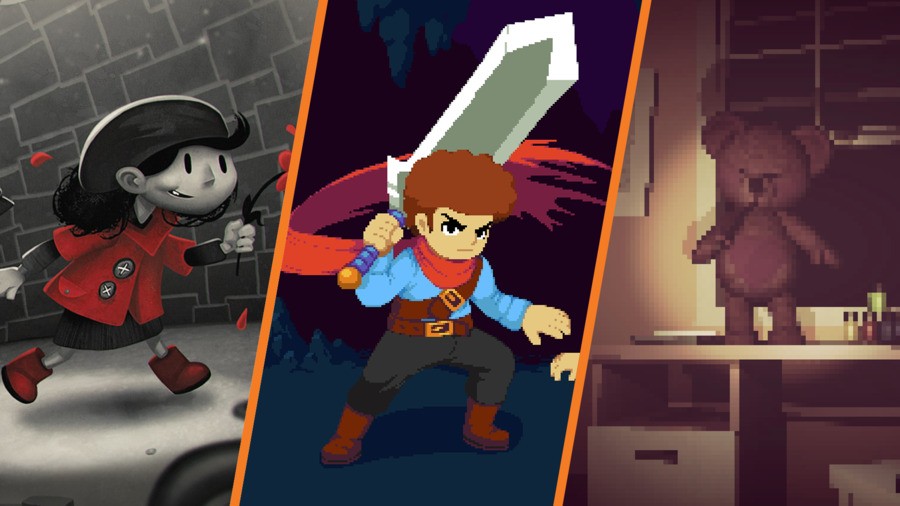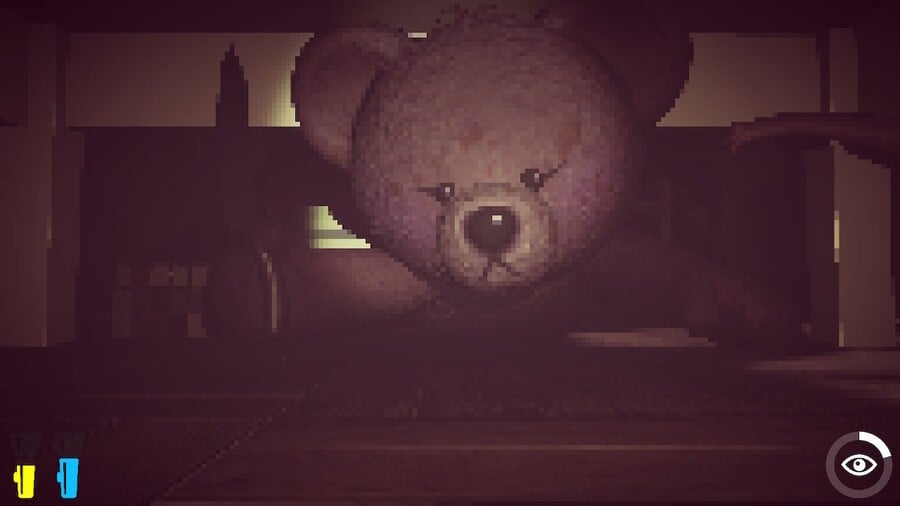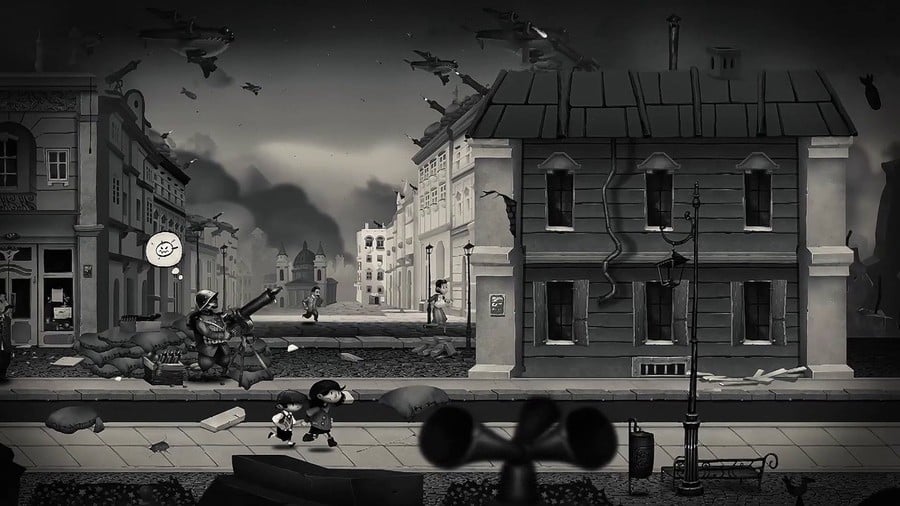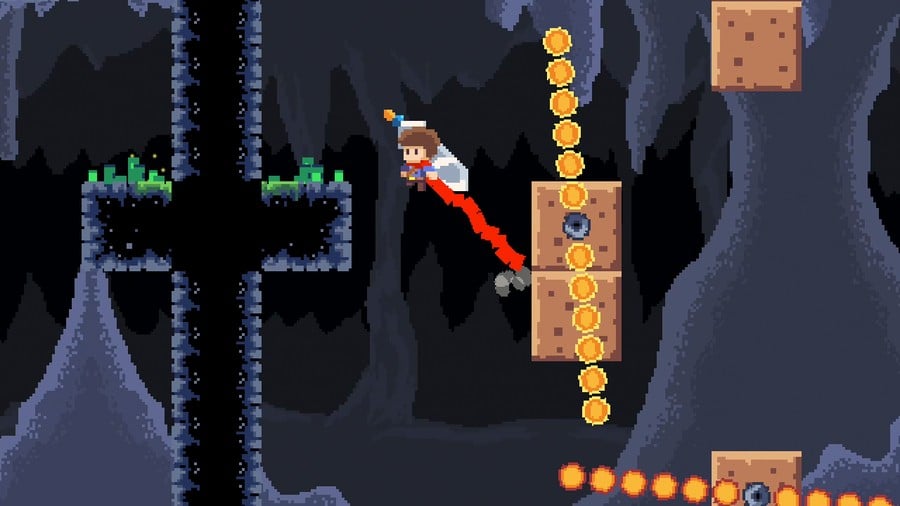
This week we have a game heavily influenced by WWII, one paying homage to the writings of H.P Lovecraft and one with a visual style based on 15th-century wood carvings. If that doesn’t cement the level of variety and creativity in the indie scene, then we don’t know what does. Let’s dive in…

Bedtime Blues
A static horror adventure that takes the premise of Toy Story and gives it a horrifying twist, Bedtime Blues crafts tension competently for the most part and will likely leave more than a few players with sweaty palms. You play as a small child, armed only with a torch to ward away your sentient teddy bear (it’s never clear if it’s the same bear, or many) in various different ways. There is also a story running between each level, urging you to find clues to discover what’s going on and the history of the toys in your family. Each level is classed as an hour, with your character attempting to survive until dawn. Sound familiar?
Though the creepy atmosphere and diegetic sound are effective, once you’ve seen the jump scare animations a few times you’ll likely breeze through repeat playthroughs, fear free. It’s also impossible to discuss Bedtime Blues without at least giving a passing mention to a certain other static horror franchise that uses cuddly creatures for jump scares. Unlike Five Nights at Freddy’s, however, which juggled a genuinely unnerving atmosphere with an intriguing plot, Bedtime Blues doesn’t try anything particularly new, despite being released five years later. Even the jump scares feel weaker and only shock because of their immediacy and loudness, rather than any scary visuals; after all, it's just a bear.
That said, the aforementioned sound design is strong. The recording of ‘Mama, please kiss me goodnight’ is particularly disturbing and the bumps in the night do help to create a sense of dread. However, the pixilated visual style, while novel at first, quickly becomes tiresome. It’s clear that the retro aesthetic was an intentional choice to enhance the distorted atmosphere, but it really doesn’t add a huge amount and makes the whole thing look ugly. Overall, Bedtime Blues isn’t awful, but it lacks a lot of the depth and production value of the franchise it clearly tries to emulate. It’s serviceable and might be nice for fans of survival horror looking for something to take on the go, but certainly isn’t ground-breaking.
Maybe

Apocalipsis: Harry at the End of the World
From in-your-face nightmares to a subtler kind of melancholy, we have the point-and-click adventure title, Apocalipsis: Harry at the End of the World. The atmosphere, aesthetic and visual storytelling form the most compelling elements of this charmingly grim adventure. You play as Harry, on a journey to retrieve your love after she’s taken from you, driving you into despair. You have to trek through an assortment of creatures and demons, both internal and external, in order to try and get her back.
The black heart of Apocalipsis comes from its style, though its core gameplay is serviceable for a point-and-click adventure. You can control Harry by swapping between traditional movement, or a point-and-click approach, the latter of which is much more viable. Solving puzzles comes down to having the correct item found and equipped, and the game won’t allow you to proceed until you’ve done everything in the correct order. This can lead to a bit of guesswork, with Harry’s shrugging of his shoulders acting like a sarcastic jibe to spur you on. Earlier puzzling can be solved by simply hovering around the map to see what is interactable and working it out from there. It lacks some of the ‘aha’ moments of other genre gems, but it is still competent as a vehicle for progressing the plot forward. However, later portions do increase the difficulty and require more logical thought for advancement.
Visually, Apocalipsis is really unique, taking an interesting artistic influence of 15th-century wood carvings as its main inspiration. These bleak, grim designs paired with the dark, ambient soundtrack work to give it a droning, otherworldly, and often unnerving atmosphere, as if you’ve dived headfirst into a nightmare. This works well with the game's story elements surrounding death and the occult and leads to a surprisingly engaging (if a little depressing) experience. Overall, Apocalipsis: Harry at the End of the World is an oddly engaging game that succeeds in its creation of a sombre atmosphere through a well-told plot. It won’t please everyone, but if you’re looking for a story-driven adventure to suck you into its world, this might be worth a look.
Thumbs Up

My Memory of Us
The unconventional cocktail of a World War 2 allegory, robots, and Sir Patrick Stewart might seem like a strange choice for a platformer on paper, but My Memory of Us delivers generally strong storytelling mixed in with some solid – if conventional – gameplay. You take on the role of a pair of children, a boy and a girl, attempting to make your way through a monochrome land ravaged by tyrannically robot overlords. The story unfolds largely through dialogue-free scenes spliced with voiceover work by Sir Patrick himself, whose stately tones undeniably add kudos and weight to the story. The allegory for Nazi Germany is good at first but veers into slightly questionable territory later on as the more sci-fi elements start to clash tonally with the severity of the real-life events.
The gameplay dynamics work well between the two children, allowing for environmental puzzle solving challenges that, while not hugely challenging at first, are weaved well into the story, particularly in the tenser moments. You progress by holding hands and moving together, with different abilities awarded to each child. For example, their movement specialisms allow the girl to run and the boy to sneak past enemies, so choosing your lead allows you to solve puzzles and navigate hazards appropriately. Additionally, enemies can be warded off by the boy's use of a blinding mirror, or the girl’s slingshot.
Visually, My Memory of Us is really appealing. The choice of a black and white world parallels the dirty, grim, depressing events on which the game is loosely based, but a splash of red every now and then not only allows objects to stand out pleasingly, but has allegorical story implications that become much more apparent throughout. Overall, My Memory of Us is a solid platformer with decent puzzles, most of which are tied to the plot. It has great sound design (including exceptional celebrity voiceover work), but its main criticism is the sometimes-jarring tonal inconsistencies between creating a tangible threat from the mind of a child and the true horrors of which it is based. That said, the good absolutely outweighs the bad and the majority of the game is a delight to play through.
Thumbs Up

JackQuest: Tale of the Sword
A platformer with a focus on speed in both gameplay and story exposition, JackQuest has you take the role of Jack, a pixilated chap wielding a sentient sword so large, it’d make Final Fantasy VII's Cloud blush. It’s a fantasy-themed platformer with a rather basic ‘girl is captured, go save her’ story, but proves its mettle in combat and exploration, both of which are pretty great. The dialogue is a little clunky and not amazingly well thought out, with quite run-of-the-mill chat that could’ve done with an infusion of wit.
Where JackQuest succeeds, however, is within its gameplay, which is thankfully its prime focus. The control is very well matched, with each jump and attack feeling organic and perfectly timed. The wall jumping, in particular, is an example of something that could easily become tedious, but is instead fun to mess about with because of how excellent the control is. There are numerous power-ups and additional weapons, but we often found ourselves defaulting to the sword, as it feels so satisfying to hit things with. The special moves are also particularly pleasing to use in a tight spot. There’s an element of the Metroidvania genre when it comes to exploration too, which is welcome, as you’ll find yourself navigating one big maze and often backtracking to progress.
Enemies are well designed and sport a retro aesthetic, matched by the rest of the world. The pixilated choice works far better in a 2D platformer like this than it does in the 3D world of Bedtime Blues. Here its use is charming, matching the humble plot and simplistic, yet well-designed controls. The boss battles are impressive, but again, tend to be quite simple once you’ve established the pattern. Musically, it has a cool, old school vibe that matches the graphics, though the grunts and groans from Jack every time he swings do wear thin after a while. Overall though, JackQuest: The Tale of the Sword is a charming platformer that revels in its own simplicity. The control is excellent, the graphics nostalgic, and the exploration elements engaging. As the official description describes its collectables and secrets; ‘they’re sure to keep completionists engaged for hours on end.’ We couldn’t have said it better ourselves.
Thumbs Up

The Shrouded Isle
We finish up this week with a unique premise; a management sim game where you must weigh up the vices and sins of villagers to work out which should be sacrificed to your God, Chernobog. The Lovecraftian theme works brilliantly in this dark, yet engaging sim. You take on the role of a High Priest, trying to appease the sleeping monster God with a sacrifice every season. The concept is really unique and the end product clearly has had a lot of passion and effort put into it, which shines through.
The main goal is to interrogate villagers, assigning one member of each of the five houses to do the good Lord’s work, whilst you secretly work out their true intentions and inevitably silence one of them per season. You’ll have to manage this with the opinions of both the houses and the wider villagers however, ensuring that tasks are being carried out appropriately, so it’s a juggling act of choosing someone who is hated enough that their sacrifice won’t cause outrage, while also picking people who’ll get the jobs done. For example, choosing the same house twice in a row for the deadly deed will likely earn the anger of that particular family in the long term, so choose wisely. The different personalities are randomly generated and a small amount of background is given, which adds a nice amount of depth. You’re also given the opportunity to nickname any of your chosen team for further attachment value. The sinners are fairly easy to root out with the use of your limited number of enquiries, while managing the other aspects of the town is generally more challenging. There are also several different endings, leading to some great replay value.
The Shrouded Isle opts for a green and black palette which, while definitely in line with its Lovecraftian influences, can be pretty grating to stare at for long periods of time, particularly on the Switch's screen. It’s a shame too, as the addiction value is high, so a long playthrough could be on the cards. The visuals are nicely drawn, but limited to only a few still images and cutscenes. The splash of red blood amidst the green dirge is a really cool addition, too. The use of church bells and foreboding sound effects also make for a spot-on soundtrack. In review, The Shrouded Isle is a great management sim that is let down purely by its choice of aesthetic. Somewhat akin to the ill-fated red and black visuals of the Virtual Boy, the palette is really nasty to stare at, but if you’re able to look past this, you’ll find a solid experience.
Thumbs Up
Will you be giving your own thumbs up to any of the above games? Let us know in the comments down below…



Comments 14
Shrouded Isle seems pretty cool, might have to wait for it to go on sale some day.
@NintendoFan4Lyf
If the games are good at what they do, they shouldn't be getting a thumbs down.
There are many more indie titles releasing than those Nat finds time for, and I don't know if you agree with me on this, but I think it would be somewhat pointless for him to deliberately go after the ones that look bad, just so he can get to dole out some downward thumbs.
Even if it can be fun to be mean.
As the system stands, it will just reveal which games fail, or even fail severely, at living up to their promises.
Given the choice of games in this golden era of console gaming, a Maybe rating is equivalent to thumbs down for most people.
I do like Apocalipsis. It's a pretty unique experience.
Church bells and Lovecrafty and management grab me so Shrouded Isle looks like love.
My Memory of Us, Engage!!!!
@NintendoFan4Lyf thumbs up is the new 8/10. I jest. I actually really like this new quick indie taster format.
@NintendoFan4Lyf
I was always told that the whole point of having thumbs was to put them down and if that’s not the case then why do we have them cause otherwise i’m not seeing a useful application?
I'll be waiting for Physical before deciding.
Shrouded Isle was great on PC. Might have to double dip, as I didnt spend as much time with it, as I wouldve liked.
I love these articles.
I highly recommend you include Football Heroes Turbo in one of them. I get the sense it totally flew under the radar, perhaps b/c visually it isn't as flashy as the terrible playing NBA Playgrounds.
Football Heroes Turbo - if you like arcade style football like Tecmo Bowl, but want it with a deep modern meta - is WONDERFUL!
@NintendoFan4Lyf
There are so many games coming out I'm sure they could find some thumbs down-able games if they tried but I think they're actually trying really hard to find and cover the best releases instead.
Glad to see jack quest is good. I'll probabaly pick it up. Been eyeing it for a while
I am sorry but JackQuest sounds filthy. Well I am not really sorry, more bored and wasting time.
@GhostGarrity if that's the case then the review aspect of these features would be a little pointless. If only good games have been chosen, just lead with that and let us know from the get go. They don't need to tell us after each one that it also got a thumbs up
Shrouded Isle and Apokalipsis look good. Will not wait for a sale, but if one happens at my payday I will be happy.
Tap here to load 14 comments
Leave A Comment
Hold on there, you need to login to post a comment...